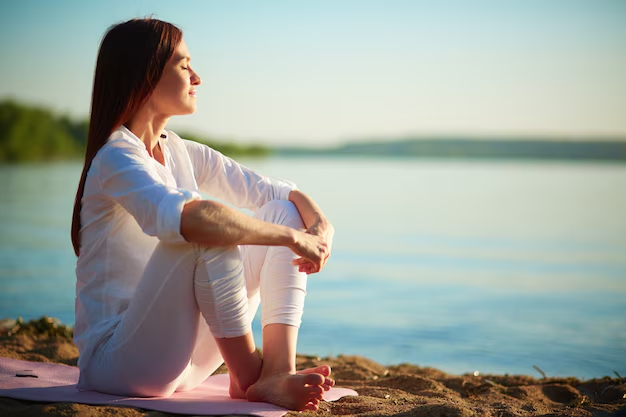In today’s fast-paced world, stress has become an inevitable part of life. From work pressure and family obligations to personal challenges, it’s easy for stress to build up and take a toll on our mental health. Chronic stress can lead to a variety of health issues, such as anxiety, depression, sleep disorders, and even physical health problems like heart disease.
However, one of the most effective ways to manage and reduce stress is by incorporating mental health exercises into your daily routine. These exercises not only help to reduce stress in the moment but also contribute to long-term emotional resilience and well-being. In this article, we’ll explore five mental health exercises that you can practice every day for stress relief.
Key Takeaways
- Mindful movement helps reduce stress and fosters emotional well-being by promoting mindfulness, body awareness, and relaxation.
- Practices like yoga, Tai Chi, dance, and walking meditation can enhance mood, reduce symptoms of anxiety and depression, and improve emotional resilience.
- Mindfulness and breath control are integral to mindful movement, promoting a calm and balanced state of mind.
- Regular practice of mindful movement, even for just a few minutes a day, can significantly improve mental health and emotional regulation.
- Mindful movement practices are accessible to people of all fitness levels and can be adapted to fit individual needs, making them an inclusive and empowering form of self-care.
1. Deep Breathing Exercises
Overview:
Deep breathing exercises are one of the most effective and simple ways to reduce stress. When we experience stress, our breathing becomes shallow and rapid. Deep breathing helps to reverse this response by activating the parasympathetic nervous system, which promotes relaxation. The deep breathing exercise focuses on slow, deliberate inhalation and exhalation, helping to calm the mind and body.
How to Do It:
- Find a quiet space: Sit or lie down in a comfortable position, preferably in a quiet area where you won’t be disturbed.
- Take a deep breath: Breathe in slowly through your nose for a count of four. Feel your lungs fill up with air.
- Hold your breath: Hold your breath for a count of seven.
- Exhale slowly: Exhale slowly through your mouth for a count of eight. Try to release as much air as possible.
- Repeat: Do this for at least five minutes, and repeat the cycle for 3-5 rounds.
Benefits:
- Reduces the production of stress hormones.
- Helps to focus the mind and alleviate feelings of anxiety.
- Promotes relaxation and improves overall emotional well-being.
2. Progressive Muscle Relaxation (PMR)

Overview:
Progressive muscle relaxation (PMR) is a stress reduction technique that involves tensing and relaxing different muscle groups in the body. This practice helps to identify and release physical tension that may have built up as a result of stress.
How to Do It:
- Sit or lie down comfortably: Ensure that your environment is calm and free of distractions.
- Focus on one muscle group at a time: Start with your feet, and tense the muscles for 5-10 seconds, then release and relax the muscles for 20-30 seconds.
- Work your way up the body: Progressively tense and release each muscle group as you move up through the body, from your feet to your head.
- Focus on the contrast: Pay attention to how your muscles feel when tense and how they feel when completely relaxed.
- Finish with deep breathing: After completing the muscle groups, practice deep breathing to further relax your body and mind.
Benefits:
- Reduces physical tension associated with stress.
- Increases awareness of how stress manifests in the body.
- Promotes relaxation and calmness.
3. Mindfulness Meditation
Overview:
Mindfulness meditation is a mental health exercise that focuses on staying present in the moment. This practice encourages you to observe your thoughts, feelings, and physical sensations without judgment, which can help reduce stress and anxiety. Mindfulness meditation is particularly useful in breaking the cycle of overthinking and ruminating, which can often increase stress levels.
How to Do It:
- Find a quiet space: Choose a place where you won’t be disturbed for 5-10 minutes.
- Sit in a comfortable position: You can sit cross-legged or on a chair with your back straight. Rest your hands on your lap or knees.
- Focus on your breath: Close your eyes and begin by taking a few deep breaths. Focus on the sensation of the breath entering and leaving your body.
- Observe your thoughts: As thoughts arise, simply notice them without judgment. Acknowledge them and let them pass, gently bringing your attention back to your breath.
- Continue for 5-10 minutes: Aim for a short practice initially, gradually increasing the time as you become more comfortable.
Benefits:
- Reduces anxiety and stress by promoting present-moment awareness.
- Improves emotional regulation and self-awareness.
- Enhances relaxation by calming the nervous system.
4. Journaling
Overview:
Journaling is a powerful mental health exercise that involves writing down your thoughts and feelings. Expressive writing can provide a healthy outlet for stress and can help you process and make sense of overwhelming emotions. By putting your thoughts on paper, you release them from your mind, reducing their ability to cause stress.
How to Do It:
- Set aside time each day: Allocate a few minutes each day to journal, preferably in the morning or before bed.
- Write freely: Start by writing about your day, how you’re feeling, or any stressors you’re experiencing. Don’t worry about grammar or structure—just write freely and without censorship.
- Reflect on your emotions: Use journaling as a tool to process difficult emotions and reflect on your stressors.
- Practice gratitude: Include a gratitude section at the end of each journal entry, writing down 3 things you are grateful for. This helps shift your focus to the positive aspects of your life.
Benefits:
- Reduces stress by providing an outlet for emotions.
- Increases self-reflection and emotional clarity.
- Improves mental well-being by focusing on positive aspects of life.
5. Visualization or Guided Imagery

Overview:
Visualization or guided imagery is a relaxation technique where you mentally picture a peaceful, calming scene or experience. By imagining a serene environment, you can activate the body’s relaxation response, reducing stress and promoting mental clarity. This exercise helps you escape from stressful thoughts and temporarily immerse yourself in a peaceful mental space.
How to Do It:
- Find a quiet space: Sit or lie down in a comfortable position in a distraction-free area.
- Close your eyes and breathe deeply: Take a few deep breaths to help center yourself.
- Create a mental image: Picture yourself in a peaceful place—such as a beach, forest, or mountain top. Visualize the sights, sounds, and smells of that place.
- Immerse yourself: Focus on the sensations of relaxation in your body as you mentally “experience” your peaceful environment.
- Return to the present: Gradually bring your attention back to your surroundings after a few minutes, carrying the calm feeling with you.
Benefits:
- Reduces stress by shifting focus away from negative thoughts.
- Helps to calm the mind and body, lowering anxiety levels.
- Enhances creativity and problem-solving by allowing the mind to relax.
In the modern world, we are constantly faced with an overwhelming number of demands and pressures that can take a significant toll on our emotional and mental well-being. The effects of chronic stress, anxiety, and depression can be debilitating, making it difficult to find the time or motivation to take care of our mental health. However, one effective way to alleviate these challenges is through mindful movement.
Mindful movement is a practice that merges physical movement with mindfulness, helping you reconnect with your body, regulate emotions, and reduce stress. It allows you to focus on the present moment, fostering a sense of calm, clarity, and emotional balance. This practice can involve a variety of exercises, including yoga, Tai Chi, dancing, and even walking, all of which can benefit your mental health in powerful ways. In this article, we will explore several mindful movement practices and how they can significantly improve your emotional well-being.
1. Yoga: Cultivating Mind-Body Connection for Stress Relief
Overview:
Yoga is one of the most well-known forms of mindful movement. Rooted in ancient traditions, yoga integrates physical postures (asanas), controlled breathing (pranayama), and meditation to promote mental clarity, physical flexibility, and emotional calm. Yoga offers a holistic approach to emotional well-being by helping individuals build resilience to stress, improve self-awareness, and foster a deeper connection to their inner selves.
How to Practice:
- Set the Intention: Begin your practice with a moment of mindfulness. Set a clear intention to focus on your breath and body during the practice.
- Choose Poses for Mindfulness: Start with grounding poses like Mountain Pose (Tadasana) or Child’s Pose (Balasana). As you transition through each pose, pay close attention to how your body feels.
- Focus on Your Breath: As you move, connect each posture with an inhale or exhale. This will help bring your mind back to the present moment, preventing it from wandering into anxious thoughts.
- End with Meditation: Conclude your practice with a few minutes of meditation or relaxation (Savasana) to fully integrate the benefits of the yoga session.
Benefits for Emotional Well-Being:
- Reduces symptoms of anxiety, depression, and stress.
- Enhances self-awareness and mindfulness.
- Promotes relaxation through deep breathing.
- Builds emotional resilience by teaching self-compassion and patience.
2. Tai Chi: Slow and Gentle Movement for Inner Peace
Overview:
Tai Chi, a form of martial art originating in China, is characterized by slow, flowing movements that promote relaxation, balance, and mental clarity. It is often described as “meditation in motion” because of its focus on mindfulness, breathing, and cultivating a sense of inner calm. Tai Chi is particularly beneficial for individuals looking to reduce stress and improve their emotional well-being through a gentle and accessible practice.
How to Practice:
- Find Your Stance: Begin by standing with your feet shoulder-width apart, knees slightly bent, and your hands resting by your sides.
- Focus on Slow Movements: Move through the Tai Chi sequence slowly and deliberately, paying attention to your breath and the fluidity of each motion.
- Synchronize Breath with Movement: Each movement should be in sync with your breathing. Inhale as you expand, and exhale as you contract, letting your breath guide the flow.
- Practice Mindfully: While practicing, remain aware of your thoughts and feelings. If your mind begins to wander, gently bring your attention back to your body and breath.
Benefits for Emotional Well-Being:
- Calms the nervous system and reduces stress levels.
- Enhances balance and emotional stability.
- Improves focus and mental clarity.
- Helps to manage symptoms of anxiety and depression.
3. Dance: A Creative Outlet for Emotional Expression

Overview:
Dance offers a unique form of mindful movement, providing an opportunity for emotional expression through rhythm and body movement. Dance encourages free-flowing, spontaneous movement that can be both therapeutic and uplifting. Whether you engage in structured dance forms like ballet or let loose with improvisational dance, this practice helps release emotional tension and promotes a sense of joy and freedom.
How to Practice:
- Choose Your Music: Select music that resonates with your current emotional state—whether upbeat and energetic or slow and calming.
- Move Freely: Let your body move to the rhythm of the music without worrying about technique or form. Focus on the sensations in your body as you dance.
- Express Your Emotions: Allow yourself to express any emotions that arise during the dance. Whether it’s joy, sadness, or frustration, dance can be a powerful tool for emotional release.
- Be Present: Let go of distractions and be fully present in the experience, focusing on how your body feels as you move.
Benefits for Emotional Well-Being:
- Promotes emotional expression and self-awareness.
- Releases pent-up tension and stress.
- Increases feelings of joy, freedom, and creativity.
- Improves mood and provides a sense of empowerment.
4. Walking Meditation: Mindfulness in Motion
Overview:
Walking meditation is a simple yet highly effective practice that integrates mindfulness with the rhythmic movement of walking. This practice is especially beneficial for those who find it difficult to sit still for meditation. By bringing your attention to each step and your breathing, walking meditation helps you stay grounded in the present moment, calming both the mind and body.
How to Practice:
- Choose a Peaceful Location: Find a quiet place where you can walk without distractions—whether it’s in a park, a quiet street, or your own backyard.
- Walk Slowly and Mindfully: Begin walking slowly, paying attention to each step as you lift your foot, move it forward, and place it back down.
- Focus on Your Breath: As you walk, synchronize your steps with your breath—inhale as you take a step, exhale as you take another.
- Stay Present: If your mind wanders, gently guide your attention back to the rhythm of your walking and your breath.
Benefits for Emotional Well-Being:
- Reduces stress and calms the mind.
- Enhances focus and mindfulness.
- Connects you to the present moment and fosters a sense of peace.
- Improves emotional clarity and reduces anxiety.
5. Body Scan Meditation: Releasing Tension and Stress
Overview:
While not a movement-based exercise, body scan meditation is a powerful tool for releasing physical tension that can accumulate as a result of stress. This practice involves mentally scanning your body from head to toe, paying attention to areas of tension or discomfort and consciously releasing it. By promoting awareness of where stress manifests physically, this exercise can help foster emotional well-being and relaxation.
How to Practice:
- Find a Comfortable Position: Lie down or sit in a comfortable position in a quiet, calm space.
- Focus on Your Breath: Begin by taking a few deep breaths, settling into the present moment.
- Scan Your Body: Start at the top of your head and mentally scan each part of your body, moving down through your neck, shoulders, chest, arms, and so on. Pause at each body part and notice if there is any tension.
- Release Tension: As you focus on each area, breathe into it and allow the tension to melt away as you exhale.
- End with Relaxation: Finish the body scan by taking a few more deep breaths, feeling the relaxation spread through your entire body.
Benefits for Emotional Well-Being:
- Releases physical tension linked to emotional stress.
- Increases awareness of how stress manifests in the body.
- Promotes relaxation and emotional clarity.
- Encourages a sense of calm and mental stillness.
Also Read: How Can Coaches Support The Mental Health Of Athletes?
Conclusion
Mental health exercises are essential tools in the fight against stress, offering both immediate relief and long-term benefits. Incorporating these five exercises—deep breathing, progressive muscle relaxation, mindfulness meditation, journaling, and visualization—into your daily routine can help you regain control over your emotions and reduce the negative effects of stress.
By dedicating just a few minutes each day to these practices, you can cultivate a sense of inner calm, improve your emotional well-being, and build resilience against life’s challenges. Remember that stress is a natural part of life, but it doesn’t have to control you. Through consistent practice, you can take charge of your mental health and find peace even in the most stressful moments.
FAQs
1. How often should I practice these exercises for stress relief?
It’s recommended to practice these exercises daily for maximum effectiveness. Even dedicating 5-10 minutes a day to these exercises can lead to noticeable improvements in your stress levels over time.
2. Can these exercises help with anxiety?
Yes! These exercises, particularly mindfulness meditation and deep breathing, are proven to help reduce symptoms of anxiety by calming the nervous system and promoting relaxation.
3. Do I need any special equipment to do these exercises?
No, most of these exercises require no special equipment—just a quiet space where you can focus and a commitment to practice regularly.
4. How long should I spend on each exercise?
You can start with 5-10 minutes for each exercise and gradually increase the duration as you become more comfortable. The key is consistency.
5. Can I do these exercises before bed to help with sleep?
Absolutely! Many of these exercises, especially deep breathing, progressive muscle relaxation, and visualization, are excellent for promoting relaxation and improving sleep quality.
6. Are there any side effects to these exercises?
There are generally no negative side effects to practicing these exercises. However, it’s important to listen to your body and stop if you feel lightheaded or uncomfortable.
7. Can I combine these exercises with other forms of stress relief?
Yes, combining these exercises with physical activities like yoga or walking can create a holistic approach to managing stress.




